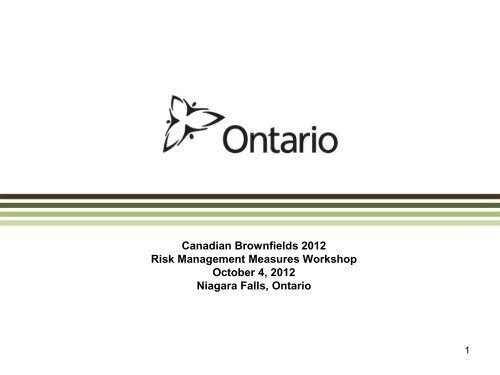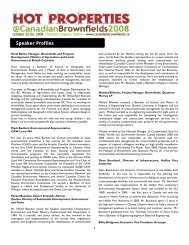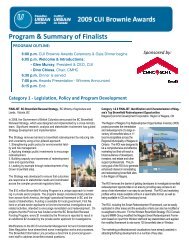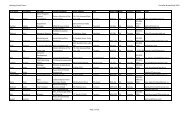Jonathan Fernandes, Ministry of Environment ON - Canadian ...
Jonathan Fernandes, Ministry of Environment ON - Canadian ...
Jonathan Fernandes, Ministry of Environment ON - Canadian ...
Create successful ePaper yourself
Turn your PDF publications into a flip-book with our unique Google optimized e-Paper software.
<strong>Canadian</strong> Brownfields 2012<br />
Risk Management Measures Workshop<br />
October 4, 2012<br />
Niagara Falls, Ontario<br />
1
Purpose<br />
• To provide an overview <strong>of</strong> how the <strong>Ministry</strong><br />
establishes and enforces Risk Management<br />
measures:<br />
• Process for developing Risk Management Measures;<br />
• Intent <strong>of</strong> the Certificate <strong>of</strong> Property Use (CPU);<br />
• Compliance with Certificate <strong>of</strong> Property Use.<br />
2
Developing<br />
Risk Management Measures<br />
• RMMs are proposed by a proponent at the time <strong>of</strong> the Risk Assessment<br />
(RA) submission;<br />
• While the RA is reviewed by Standards Development Branch, the RMMs<br />
are reviewed and commented on by the District Engineer;<br />
• Schedule C <strong>of</strong> O.Reg 153/04 details the legal requirements for RA’s;<br />
• Table 1, Section 7. specifically detail the legal requirements <strong>of</strong> the Risk<br />
Management Measures;<br />
• Some abatement activities can also be addressed through the RMMs and<br />
the CPU. (i.e. on site barriers to prevent future <strong>of</strong>f site migration <strong>of</strong><br />
contaminants, pump and treat systems)<br />
3
Developing<br />
Risk Management Measures<br />
• After the RA is complete, District Engineer verifies the RMMs and develops<br />
the CPU;<br />
• The District Engineer verifies that the RMMs are supportive <strong>of</strong> the RA<br />
findings (ie. ensure exposure pathways are blocked through RMMs);<br />
• The project design to meet engineering specifications are also reviewed;<br />
• Consultation with the District Office (District Engineer);<br />
• The <strong>Ministry</strong> has internal business process in place for development and<br />
issuance <strong>of</strong> CPU (including posting <strong>of</strong> the CPU on the <strong>Environment</strong>al Bill <strong>of</strong><br />
Rights Registry).<br />
4
CPUs are:<br />
Intent <strong>of</strong> the<br />
Certificate <strong>of</strong> Property Use<br />
• For sites that require risk management measures (RMMs) to be<br />
implemented in support <strong>of</strong> the RA;<br />
• Are the only legal document (control document) that can be issued to<br />
enforce the RMMs;<br />
• Issued by the local District Office by the appointed Director (District<br />
Manager);<br />
• Can include development <strong>of</strong> Soil Management Plans and Financial<br />
Assurance;<br />
• Are a Class II instrument under the <strong>Environment</strong>al Bill <strong>of</strong> Rights and require<br />
30-45 days posting for public consultation (Tier 3 only);<br />
• May also require a Certificate <strong>of</strong> Requirement to be registered on title <strong>of</strong> the<br />
property to provide anyone dealing with the property notification <strong>of</strong> the CPU.<br />
5
Compliance with the Certificate <strong>of</strong><br />
Property Use<br />
• A CPU is a legally binding control document;<br />
• Compliance is undertaken by the District/Area <strong>of</strong>fices <strong>of</strong> the MOE<br />
across the province;<br />
• A formal inspection program was initiated in 2011/2012 to<br />
standardize the inspection form to ensure consistency;<br />
• There are approximately 128 CPUs issued (March 2012) since<br />
Ontario Regulation 153/04 came into force;<br />
• Once a CPU is issued it may take a number <strong>of</strong> years before the<br />
development is complete and the RMMS have been implemented or<br />
constructed.<br />
6
Compliance with the Certificate <strong>of</strong><br />
Property Use<br />
• The MOE inspection focuses on:<br />
• General property information;<br />
• Site ownership;<br />
• Ensuring that the owner is aware <strong>of</strong> their legal obligations in the CPU (especially<br />
if there is a change in ownership);<br />
• Annually reporting;<br />
• Monitoring/maintenance and retention <strong>of</strong> records;<br />
• Part 4 which contain the Directors Requirements and the Risk Management<br />
Measures.<br />
• The inspection also reviews whether the conditions are still required<br />
and need to be maintained.<br />
• For any non-compliance identified, the <strong>Ministry</strong> will take appropriate<br />
follow-up abatement actions to bring the site into compliance with<br />
the CPU requirements.<br />
7
Discussion<br />
• Are they’re any issues or concerns with<br />
the content <strong>of</strong> the CPU??<br />
• What are the challenges or obstacles in<br />
meeting the requirements <strong>of</strong> the CPU?<br />
• Is there any particular guidance needed to<br />
meet the expectations <strong>of</strong> the MOE??<br />
8












